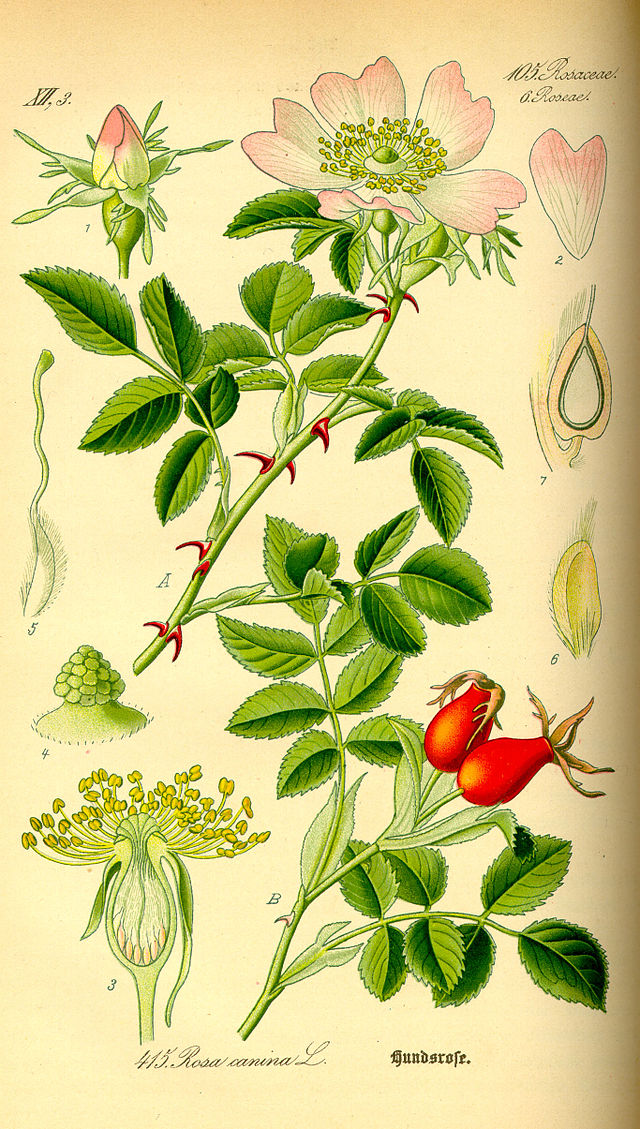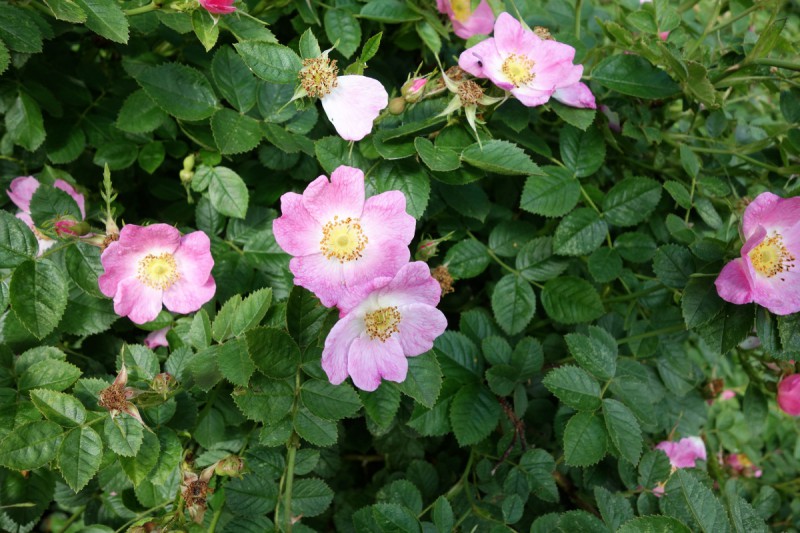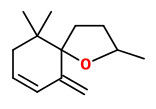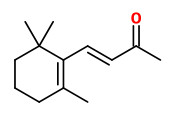Dies ist eine alte Version des Dokuments!
Rosa canina L. - Rosaceae - dog rose, common brier, dog brier, Hagebutte, Hunds-Rose, Hagrose
Deciduous spiny shrub, 1-3m high, native to Europe, Southwest Asia, Northwest Africa; introduced to North America and New Zealand; leaves odd-pinnate (5 or 7 leaflets); flowers solitary, pale pink.
Dried, ripe fruits with the seeds removed (Rosae pseudofructus, Fructus Cynosbati sine Semine) are used traditionally as diuretic and „… to treat a diversity of ailments of the gastrointestinal tract and nowadays mainly to enhance the flavour of mixtures. Seeds are a traditional diuretic and used against various disorders of the urinary tract.“
[Medicinal Plants of the World. Ben-Erik Van Wyk and Michael Wink, Pretoria 2004, 275]
Main volatile compounds found in the essential oil of rose hips of R.canina were vitispirane (10.3%), 5-methyl-3-hexanone and 2-heptanone (together 7.4%), β-ionone (5.4%), α-E-acaridial (= 2(E)-(4-methyl-3-pentenyl)butenedial, 5.1%), 6-Methyl-5-hepten-2-one (3.4%), and nonanal (2.5%).
[Chemical composition of hips essential oils of some Rosa L. species. Nowak, R., Z Naturforsch C, Vol.60(5-6), 2005, 369-378]
The ethanolic extract of Rosa canina L. (Rosaceae) fruits „…was shown to possess significant inhibitory activity against inflammatory models (i.e., carrageenan-induced and PGE1-induced hind paw edema models, as well as on acetic acid-induced increase in a capillary permeability model) and on a pain model based on the inhibition of p-benzoquinone-induced writhing in mice. Hexane, chloroform, ethylacetate, n-butanol and the remaining water fractions were obtained through bioassay-guided fractionation. Ethylacetate and n-butanol fractions displayed potent anti-inflammatory and antinociceptive activities at a dose of 919 mg/kg without inducing acute toxicity. Further attempts to isolate and define the active constituent(s) were inconclusive, possibly due to the synergistic interaction of components in the extract.“
[In vivo anti-inflammatory and antinociceptive activity of the crude extract and fractions from Rosa canina L. fruits., Orhan, D.D., Hartevioğlu, A., Küpeli, E., Yesilada, E., Journal of ethnopharmacology, 112(2), 2007, 394-400]
„While the water and methanol extracts were inactive in the COX-1, COX-2 and LTB4 inhibition assays, the n-hexane and the dichloromethane extracts inhibited all three enzymes. In the active extracts, the triterpenoic acids ursolic acid, oleanolic acid and betulinic acid were identified, although only in minute amounts. Furthermore, oleic, linoleic and α-linolenic acid were identified apart from several saturated fatty acids. Even though unsaturated fatty acids are known to be good inhibitors of COX-1, COX-2 and LT formation, no clear correlation between their concentration in the extracts and their activity was found. We suggest that other, yet unidentified, lipophilic constituents might play a more important role for the observed in vitro inhibitory activity on arachidonic acid metabolism. Some of the extracts also showed considerable DPPH radical scavenging activity, the methanolic extracts being most potent. The radical scavenging activity of the extracts correlated very well with their total phenolic content, while ascorbic acid contributes only little to the radical-scavenging activity due to its low concentration present in the extracts.“
[Phytochemical composition and in vitro pharmacological activity of two rose hip (Rosa canina L.) preparations., Wenzig, E.M., Widowitz, U., Kunert, O., Chrubasik, S., Bucar, F., Knauder, E., Bauer, R., Phytomedicine, 15(10), 2008, 826-835] http://www.sciencedirect.com/science/article/pii/S094471130800127X
The fruit flesh of rose hips from R.canina growing wild in Turkey contained large amounts of ascorbic acid (2.2%) and was very rich in potassium, calcium and magnesium.
[Variations in Chemical Compositions of Rosa damascena Mill. and Rosa canina L. Fruits. Kazaz, S., Baydar, H., Erbas, S., Czech J. Food Sci. Vol.27(3), 2009, 178-184]
http://www.sonerkazaz.com/wp-content/uploads/Variations-in-Chemical-Compositions-of-Rosa-damascena-Mill.-and-Rosa-canina-L.-Fruits.pdf
The main components of the essential oil of R.canina leaves fro Tunisia (0.1-0.2% v/w), collected by hydrodistillation, were palmitic acid (15-23%) and vitispirane (9-22%).
[Phenols, essential oils and carotenoids of Rosa canina from Tunisia and their antioxidant activities., Ghazghazi, H., Miguel, M.G., Hasnaoui, B., Sebei, H., Ksontini, M., Figueiredo, A.C., Barroso, J.G., African Journal of Biotechnology, 9(18), 2010, 2709-2716]
„Data show that the Rosa canina extract inhibits the development of carrageenin-induced edema; the anti-inflammatory power is similar to that of indomethacin. The antiedema effect was more significant using a higher dose of the extract. The total score expressing gastric damage was lower in Rosa canina pre-treated stomachs with respect to unpre-treated ones, although the antiulcerogenic effectiveness was not statistically significant. The antiulcerogenic effectiveness was not statistically detectable, even if the total score expressing gastric damage was lower in Rosa canina stomachs from pre-treated rats with respect to unpre-treated ones. Chemical analysis revealed that the extract owns a good antioxidant activity that may also contribute to the anti-inflammatory effects observed in vivo.“
[In vivo anti-inflammatory effect of Rosa canina L. extract., Lattanzio, F., Greco, E., Carretta, D., Cervellati, R., Govoni, P., Speroni, E., Journal of ethnopharmacology, 137(1), 2011, 880-885] http://www.sciencedirect.com/science/article/pii/S0378874111004818

Thomé, O.W., Flora von Deutschland Österreich und der Schweiz, Tafeln, vol.3, t.415 (1885)
http://plantgenera.org/species.php?id_species=1260425

Rosa canina flowers, CC BY-SA 3.0, Author: Andreas Kraska


